Nils Georg Brekke 2018
The ideas of revitalizing the old Norwegian craft traditions of building the wooden rowing boats called Oselvar – named after the location of the boatbuilders at the Os river by Bjørnefjorden, 30 kilometers south of Bergen – came up in the late twentieth century. Two boatbuilder courses were organized at the regional museum Hordamuseet in 1980 and 1982, held by retired, but highly skilled and trained boatbuilders from two of the fjord villages in Os municipality, Askvik and Lysefjorden. These courses were met with great interest and gathered a group of younger boatbuilders and local craft historians. The initiative was taken by one of the board members in the Arts and Crafts Society in Bergen, in cooperation with the boatbuilders’ own business company – Os Båtbyggjarlag – where only two boatbuilders were still active at the end of the 1980s; Harald Dalland from Tysnes and Nils Olav Solbakken from Austevoll, in the neighbouring island district.
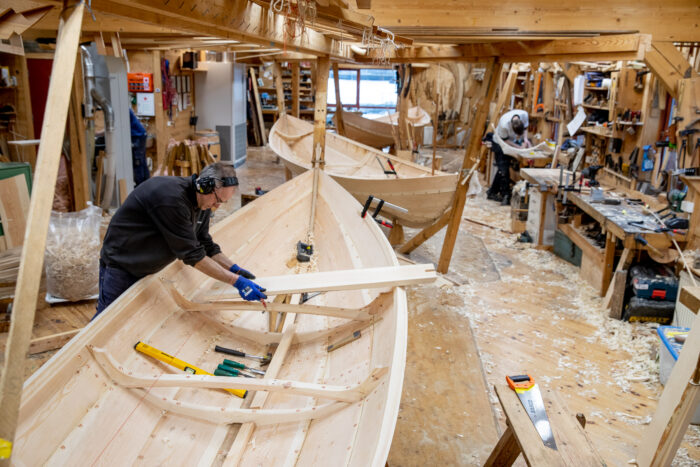
Photo: Vidar Langeland
The three-boarded rowing boat has been built in the landscapes bordering Bjørnefjorden probably since the Middle Ages. This historic tradition represents a classic combination of resources, household, craft and skill: the farmerboatbuilders of the fjord region, with good access to the pine forest, built and sold boats to the fisherman-farmers in the coastal district. Through many centuries this has been a cooperation for mutual benefit, from the Viking Age to our days – fish from the coast in exchange for timber from the fjord mountains. In the 1980s a fundamental change in technique and materials occurred: the shift from wooden boats to plastic cruisers, reflecting the growing prosperity of the Norwegian society. It was consequently a natural decline in the demand for wooden boats, and the boatbuilders became fewer in number. The art of building wooden boats was about to become part of «the forgotten arts».
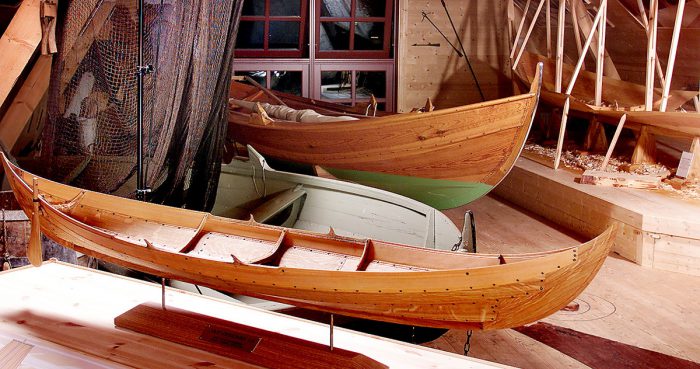
The Oselvar is a light and rapid boat, well fitted for rowing and sailing, appreciated by the fishermen and for leisure use aswell. It is still built in accordance with the design of three broad boards, and today’s boats have a remarkable resemblance to the small boats which were found in the Gokstad viking ship from the tenth century, excavated in 1880 near Sandefjord in the eastern part of Norway. These rowing boats, nearly of the same shape as the Oselvar boats, is a testimony of the art of boatbuilding through thousand years; a tradition of craft and skill handed down from father to son through many generations.
But none of the Viking ships could leave the shores for ocean sailing without large woollen sails, woven by the women at the warp-weighted loom. These sails were the product of an incredible collective enterprise which required all the women in the Viking village, each of them weaving a strip of vadmål in their own loom, and these strips were sewn together into large sails. Parallel to the tradition of boatbuilding, the art of weaving has been passed on through «learning by doing» in daily life, from mother to daughter through more than thousand years. In the region around Bjørnefjorden the warp-weighted loom has been in use until today, being part of the cultural heritage of traditional female crafts and skills in the North Atlantic area. More than anything this explains the strong position of the Viking women in the contemporary society.
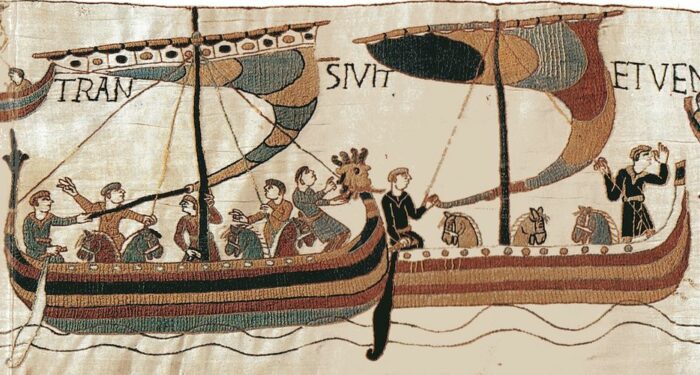
In 1986 the Norwegian government presented a plan for documentation, preservation and revitalizing of old crafts. The boatbuilding traditions and the art of weaving on the vertical loom naturally became central themes in the western part of the country. In the county of Hordaland this also gave rise to a programme for preserving and restoring the old sash saws at Stekka in Kvam and in Herand in Jondal on the Hardangerfjord. The sash saws – introduced in Norway in the sixteenth century – provided during many generations both pine boards and oak planks of special dimensions for the skilled boatbuilders in the fjord districts.
An interesting example of this craftmanship at the end of the eigheteenth century is the export of small wooden boats from the Tysnes island at the southwestern rim of the wide Bjørnefjord, inside the outskerries at Marsteinen, where sailing ships for hundreds of years headed for Shetland and the Orkney islands. The boatbuilders at Tysnes built the wooden rowing boats as a «prefabricated» sets of keel, boards and ribs, for export to Shetland, flat-packed on the deck of the ship to accommodate as many as possible. These sets were assembled into boats by the boatbuilders and fishermen on the Western isles, across the ocean from Western Norway – predating an IKEA idea by 300 years.
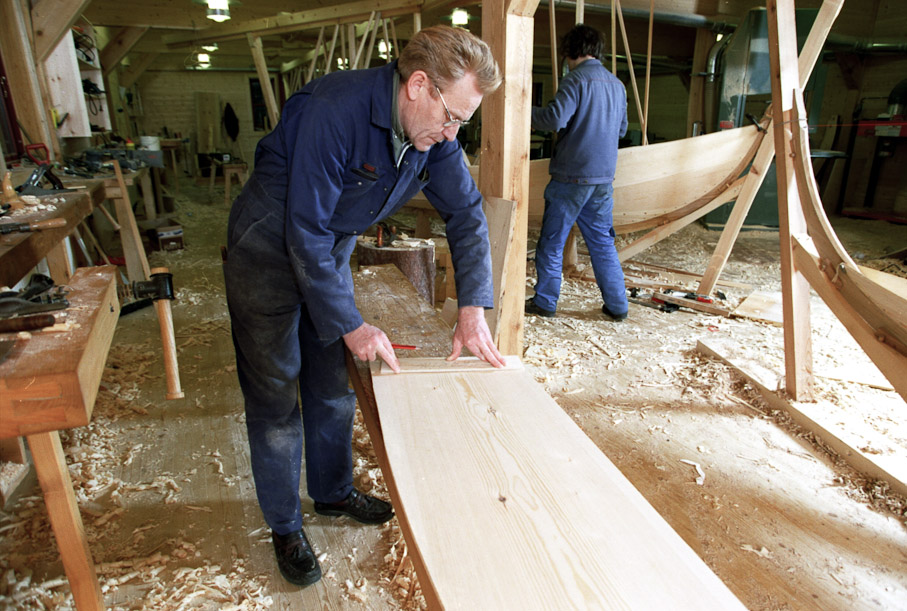
The boatbuilder Harald Dalland in Tysnes worked alone in his workshop as a boatbuilder in the middle of the 1980s, as one of the few remaining boatbuilders in this region, being a member of Os Boatbuilder Company, and there was no one to take over his profession. In 1988 an application was sent from Hordaland County Council to the central Ministry of Regional Development, who had launched a programme for support and financing of private initiatives in the districts of Norway, for the purpose of developing cultural values and activities in local communities. The County Council established a programme called The West Coast Project, to offer support, planning and financing through governmental fundings. Many themes were introduced here – e.g. the preservation of the heathlands as a cultural landscape and the old coastal pathways as a recreational area, combined with a comprehensive guide to the cultural history. A central part of the West Coast project was the preservation and revitalization of the old craft traditions of shipbuilding and boatbuilding. The first idea of re-erecting one of the boat yards on an old site at the mouth of the Os river was discussed with Harald Dalland, and he was willing to take on the role of «Master Boatbuilder» in a programme for training new and young boatbuilders, in order to revitalize the old craftmanship and thus preserve the history of the craft traditions.
At this time the cultural office in in the Municipality of Os worked out a plan for safeguarding the cultural heritage, including ideas of establishing an «Oselvarcentre» and an «Oselvar-festival». There was also a meeting between Os Boatbuilder Company and the cultural office, whhich took over the archives from the boatbuilder company. The years between 1970 and 1990 were important for the preservation of the Oselvar-tradition, and the regional museum Hordamuseet took on the responsibility for the complete boatbuilder workshop of Alfred Søvik in 1979. He was one of the most renowned boatbuilders in Os, and he has been portrayed in a film from 1972, showing all the aspects and technical details of his craftmanship. Hordamuseet has taken custody of all tools and equipment from this boatyard.
One of the key-proposals in the West Coast Project was the idea of re-establishing a boat yard near the old seahouse-sites on the Os river, in close cooperation with Os Boatbuilder Company. The preliminary draft for re-building a boatbuilder’s workshop – an Oselvar Boat Yard – was presented to Os Municipal Council in 1992 as part of the development project for «Revitalizing the village of Os».
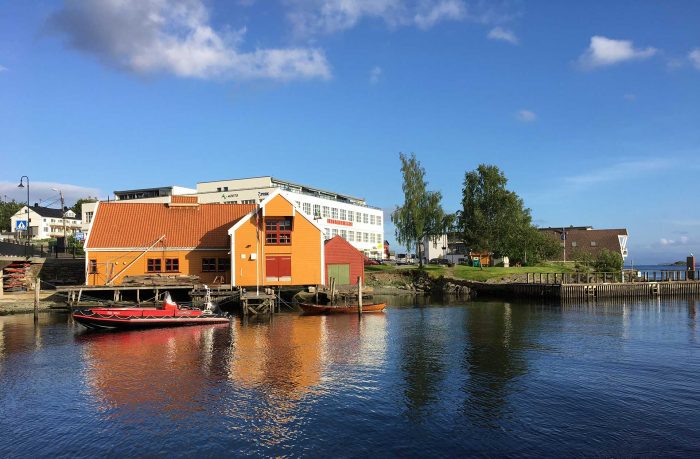
In 1993 Os municipality took over the responsibility for further planning and financing the building of a replica of a traditional seahouse, as a workshop for boatbuilding. Three successive mayors of Os, from 1993 to 1996, gave this project high priority, and the head of the cultural office of Os municipality made a great effort to secure financial support from the Norwegian Cultural Council. Os municipality was responsible for building the boat yard, which was opened in 1997.
The masterbuilder Harald Dalland took on the important task of being the instructor for the young apprentices, according to a plan for training boatbuilders for six years, and this enterprise has shown to be a good model. Without this close cooperation between the boatbuilders in Os Boatbuilder Company, Os Municipal Council and Hordaland County Council it would not have been possible to succeed with the regeneration of the craft traditions of the Oselvar-boat. And in 2008 the Oselvar Boat Yard became a member of the international Economuseum Network, wich has the overall purpose of revitalizing old arts and crafts traditions.
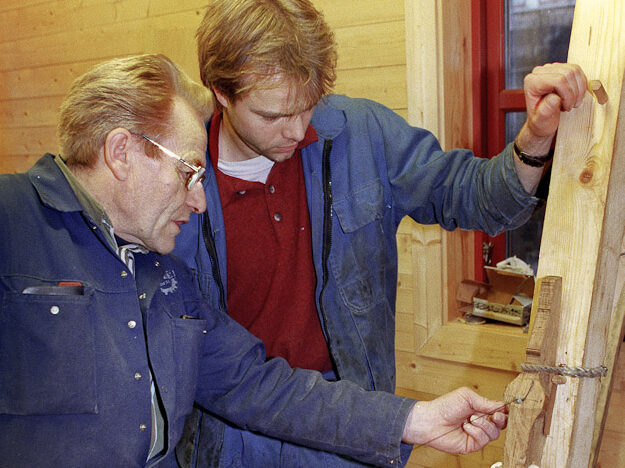
Photo: Vidar Langeland
There is an interesting parallel between the establishment of the Economuseum Network in Canada and the building of the Oselvar Boat Yard in Norway. In Canada Cyril Simard and Claude Dubè from the Laval University in Quebec have been the successive professors and chairholders for an UNESCO Chair in Cultural Heritage for two periods; Cyril Simard from 2001 to 2005, and Claude Dubè from 2005 to 2016. As part of a research project on cultural economy the planning department at the Laval university became an «incubator» for the emergence of the Economuseum concept in the 1990s. Already in 1994 Claude Dubè, in his capacity as professor at the Faculty of Planning and Architecture, became associated with The Economuseum Network Society, based on the idea that theoretical and practical knowledge of traditional crafts and techniques are essential to the understanding and preservation of cultural heritage. This is a central part of the programme for the Economuseum concept. The idea of revitalizing traditional arts and crafts as a foundation for developing new business activities, based on the craftsmen and artists themselves, who also take custody of their own history, has been characterized as «the first new idea in the museum world in hundred years».
Cyril Simard and Claude Dubè visited the Oselvar Boat Yard in 2008, when the boat yard was recognized as one of the first members of the international Economuseum Network in Europe. And it proved an especially a well suited occasion to welcome the Oselvar Boat Yard into the Economuseum Network, when it became obvious that the concept of the boat yard – revitalizing the old craftmanship and the art of boatbuilding – very closely resembled the Economuseum concept, conceived at the same time, independently of each other.
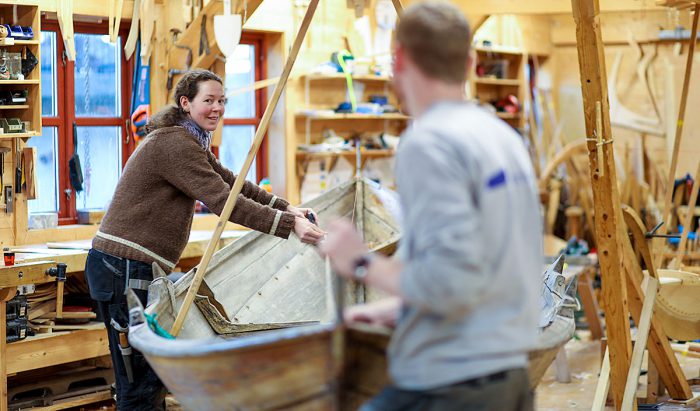
When the Oselvar Boat Yard was opened in 1997, a professional board was established, where the boatbuilder Harald Dalland was a central member. Under his leadership six boatbuilders have got their full education and training in the traditional crafts and skills and have obtained their certificate as boatbuilders. Os Municipal Council has the responsibility for the annual budgets, based on fundings from the municipality, the County Council and the incomes from the building of Oselvar boats as a traditional business activity. In 2018 one of the young boatbuilders, Berit Osmundsen, has taken over the professional leadership as «Master Boatbuilder», working together with the core group of certified boatbuilders.
Over the last twenty years the Oselvar Boat Yard thus has proven to be a success story, in preserving, safeguarding and revitalizing the old skilled craftmanship – «the art of boatbuilding».
